
A literature review of ERP system, challenges and opportunities of ERP implementation on organization*Nguyen Thuy Tien and Truong Thanh TamHong Bang International University,VietnamABSTRACTA for-profit organization believes that ERP (enterprise resource planning) system effectiveness can be achieved through long-term rather than short-term processes. Moreover, some large corporations benefit more than others from the use of ERP software. As a result, the ERP system is now live. This study aims to demonstrate the numerous benefits of effective ERP system implementation from the organization's infancy to maturity. In addition, the researcher and analyst investigate the ERP system's application in numerous businesses by analyzing and reviewing previous academic journals and research. This research employs a semi-systematic literature review as its methodology. In this research paper, the fundamental concept of the ERP system and its organizational benefits are discussed. From a review of the relevant literature, this study discusses the aforementioned statement using case studies to demonstrate the ERP experiences of various companies. This research also reveals that implementing the ERP system is regarded as one of the most challenging projects that require collaboration between ERP project members. Theoretically, there is no end date for ERP implementation, particularly after the system has been established and implemented.Keywords: ERP system, life cycle, stages, journey, system implementation, semi-systematicGlobalizaon has created compeon between domesc and foreign businesses. Globalizaon offers advantages, but it is difficult to ancipate, adapt, and act in accordance with shiing market requirements or malfeasance. To develop sustainably, organizaons must improve resource management, storage, and control. Firms require sophiscated soware to integrate and manage data from mulple departments, including accounng, sales, and vendor divisions, in order to maintain data consistency throughout all business processes. ERPs help companies achieve their objecves. In the 1970s and 1980s, MRP and MRP II were extensively used, according to Nazemi et al. (2012) [1]. MRP and MRP II relate process data in limited business contexts, such as manufacturing, in a logical manner. Individual systems are unable to aggregate the company's informaon flow, so MRP soware cannot plan, monitor, or regulate. Manual transacons predominate. ERP was implemented to resolve these problems. An ERP system is defined by Oeno [2] as "an integrated set of programs that support core organizaonal acvies, such as supply, manufacturing, logiscs, finance, sales, markeng, and human resources." Numerous ERP features make it a worldwide preference. In 2007, IDC reported that ERP licensing and maintenance accounted for $32.8 billion [3]. ERP, according to Umble et al., provides an integrated business perspecve of all funconal enes and a database process for each business transacon [4]. ERP can increase profits, reduce expenses, accelerate product development, and improve customer sasfacon [4]. Adopon of an ERP system is expensive and challenging [5]. ERP iniaves fail because company objecves and ERP capabilies are misaligned [5]. Aer decades of use and modification, ERP concerns remain ambiguous. ERP longevity has not received as much attention as deployment. This study investigates the problems and interactions of the organizational ERP life cycle. Multiple examples will illustrate the disparity between theoretical 35Hong Bang Internaonal University Journal of ScienceISSN: 2615 - 9686Hong Bang Internaonal University Journal of Science - Vol.4 - June 2023: 35-44DOI: hps://doi.org/10.59294/HIUJS.VOL.4.2023.384Corresponding Author: MBA. Nguyen Thuy Tien Email: ennt2@hiu.vn1. INTRODUCTION

36Hong Bang Internaonal University Journal of ScienceISSN: 2615 - 9686Hong Bang Internaonal University Journal of Science - Vol.4 - June 2023: 35-44analysis and practical perspective. To illustrate the ERP journey, the numerous advantages of the ERP system are first described. The five subparagraphs of the body paragraph are:- The reason why an ERP voyage can be a never-ending story; - The possible phases of an ERP system's journey; - The possible advantages of each stage; - Discussion of the company's case study, which focuses on their various benefits and drawbacks toward ERP implementation.2. LITERATURE REVIEWThis section discusses ERP literature review approaches. The investigation will be guided by this phase. Over the past decade, ERP systems have been intensively explored. This is shown by many ERP research review methodologies. Data collection and analysis are recommended. In 2007, Young B. Moon [6] evaluated peer-reviewed papers, identified the research era, utilized "ERP" as a keyword, and included surveyed journals. Between 2000 and May 31, 2006, he abstracted 79 documents. The results showed ERP research had improved, particularly in education. Over the course of a decade, Schlichter et al. [7] examined ERP knowledge growth. Their strategy entails searching certain journals rather than proceedings and books depending on duration and two keywords, "ERP" and "Enterprise Resources Planning," and then classifying ERP-related works. Thus, ERP implementation is the most fascinating issue, while academic understanding of ERP systems is mature. The assessment imagined ERP's anxieties as future interests (Figure 1).Recent assessments have focused on applicaon development and difficules because im-plementaon is popular. Shaul et al. examined ERP system implementaon crical success factors (CSF) [8]. They use journals, proceedings, and scienfic databases to create a bibliography from 1999 to early 2010. Published publicaons, defined cutoff date, and 52 searching examples from the matrix between first and second reasons drove their selecon (Table 1). Figure 1. The conceptual framework of ERP's concerns [7]

37Hong Bang Internaonal University Journal of ScienceISSN: 2615 - 9686Hong Bang Internaonal University Journal of Science - Vol.4 - June 2023: 35-44Similarly, Tobie et al. [9] used Google Scholar and Microsoft Academic Research as their database search engines to find 36 journals containing the phrases "Enterprise Resource Planning and Implementation and African Countries" and "ERP Implementation and African Countries" before assigning those articles to the desired theme. As shown in Figure 2, the critical factors of success and failure in Africa received more consideration than the others.Table 1. The search criteria and the database used in [8]Figure 2. Pie chart of published papers by issues in Africa [9]Search criteria-First Argument: Crical success factors, Factors, CSF, Issues, Barriers, Taxonomy, Success, Failure, Implementaon, Ulizaon, Adopon, Deployment, Risks Second Argument: ERP, Enterprise resource planning, Enterprise systems, Enterprise soware Journals Databases Conferences Harvard Business Review Academic Search Premier ECIS Informaon Systems Research AIS e-Library ICIS Sloan Management Review ACM Digital Library ICEIS MIS Quarterly Business Source Premier ACTS European Journal of Informaon Systems Emerald Full-text AMCIS Informaon Systems Research IEEE Xplore Digital Library PACTS Communicaons of the ACM InformaWorld Decision Sciences JSTOR European Journal of Operaonal Research ProQuest IEEE Journals Science Direct Informaon & Management Springer Link Informaon Systems Web of Science Informaon Systems Management Wiley InterScience Journal of Management Business Process Management

38Hong Bang Internaonal University Journal of ScienceISSN: 2615 - 9686Hong Bang Internaonal University Journal of Science - Vol.4 - June 2023: 35-44Ranjan et al. [10] also address four ERP implementation challenges: technology selection, change management, knowledge management, and emerging technologies. The ERP life cycle evaluation so far has just covered implementation, which may be insufficient. Nazemi et al. [1] used the ERP lifecycle framework to survey the literature on that topic. The ERP lifecycle shows how a company will deploy a system from the beginning to best practices. The ERP lifecycle helped the researchers classify the papers into six primary topics (Fig. 3). The study shows that ERP research ignores other stages of its life. As Nazemi et al. found [1], that can create unanticipated ERP success challenges. The study may indicate ERP lifecycle issues, but their interrelationship has not yet been acknowledged.Figure 3. The publicaon's categories based on lifecycle [1]3. METHODOLOGYOrganizaonal ERP system adopon is examined in academic journals and research. The literature review was semi-systemac. Snyder [11] says the literature review can help academics incorporate empirical study findings. The field is invesgated randomly and deliberately. Synthec findings and sufficient evidence in diverse domains are used to build research conceptual frameworks. Systemac Literature Review (SLR) integrates research findings logically, coherently, and reproducibly [11]. It's the review's best. Business research rarely uses this healthcare technique. Mantyla et al. [12] state that the SLR requires a dedicated database and several search-string documentaries to be researched exclusively. This study involves a narrave or semi-systemac literature review. Scholars in several fields use systemac reviews to define and study this technique. This technique helps business research by assessing complex topics and designing relevant studies. This is qualitave research. Narrave reviews help scholars plan research. Researchers understand earlier studies and tough situaons. [13] This strategy can idenfy themes, theorecal frameworks, and common research or methodology concerns. This study's review will follow two steps: First, gather "ERP," or "Enterprise Resource Planning," journals. The second step is to analyze and interpret the findings for each tle, such as why the ERP system life cycle is

39Hong Bang Internaonal University Journal of ScienceISSN: 2615 - 9686Hong Bang Internaonal University Journal of Science - Vol.4 - June 2023: 35-44"going alive," the likely stages in the ERP system journey, the possible benefits of three ERP implementaon stages, and relevant factors and challenges for reposioning companies from one stage to another.4. FINDINGS4.1. The reason why the ERP system life cycle begins with "go live"Nah et al. [14] state that operaonal ERP lifecycle implementaon is infinite. Willis and Willis-Brown [14] agree with this theorecal noon that ERP deployment has no end date, especially when it is created and executed. Long ago, corporaons considered enhancing data systems to help business processes [15]. ERP soware almost replaces the exisng corporate system to boost producvity and efficiency. ERP dominates other ICT markets, according to Sunner [15]. Avison and Fitzgerald [15] suggest that ERP system use could benefit both individuals and organizaons. Informaon is crucial to organizaonal development, and the factors needed to obtain it have been rising [15]. Thus, informac systems use ERP soware to combine all important company data [15]. Zimmerman and Semdley [15] interview managers. Aer the interview, they learn that ERP's goal is to fix system issues and develop new systemac innovaons. Baskerville and Myers [15] also argue that ERP systems aid daily corporate operaons, correct faults, and increase technical experse. ERP shapes and affects individuals in organizaonal management, according to Zimmerman and Semdley [15]. Zimmerman and Semdley [15] also discuss the importance of consultants in ERP deployment and use, organizaonal strategy, and operaon. 4.2. The probable stages in ERP system journeyNazime et al. [1] idenfied five ERP system maturity stages: adopon decision, acquision, implementaon, usage and maintenance, evoluon, and rerement. Esteves and Bohorquez [14] describe the ERP implementaon lifecycle as pre-implementaon, implementaon, and post-implementaon. Adopon, decision, and acquision are menoned by Naizme et al.Pre-implementaon, which determines decisions and processes, will have an impact on implementaon and post-implementaon [14]. This early phase includes technology overview preparaon, vendor task and internal resource decision-making, training programs, logisc strategy modificaon, pilot study posion determinaon, simultaneous modificaon decisions, and progressive phase applicaon [14]. Herold et al. [14] advise studying the nature and origin of atudes that change inial behavior, such as fighng again, involvement, and crical response. Understanding the nature and origin of these atudes [14] may help guide implementaon-stage decisions.In Implementaon stage, Abidnour-helm et al. [14] say this phase's conclusion takes me. ERP deployment might take 12–30 months [14]. This phase is crical to implementaon success since it involves several acons. In final ERP, it evaluates the performance's efficacy, credibility, data quality, and applicability [14]. Caldwell [14] said the post-stage will assess implementaon benefits aer one to three years. Nah et al. [14] listed five post-implementaon maintenance measures. Correcve, adapve, prospecve, prevenve, user support, external pares Five disnct maintenance tasks Troubleshoong, data import, and seller informaon updates are correcve maintenance. Adapve maintenance encompasses transmission, inspecon, adaptaon, and development, whereas preventave maintenance requires workflow control and administraon. User support offers a help desk and consumer training. Finally, third pares handle vendor, consultant, and user contacts.4.3. Possible advantages of three stages of ERP implementaonAli and Miller's [14] research found that pre-implementaon influences new hires' early views and ERP success. ERP deployment early on can uncover resistance, connecon, and feedback for subsequent stages [14]. Hong and Kim [3] emphasize that the pre-ERP phase affects organizaonal atudes regarding the system and installaon quality. Early and post-construcon failures can cost money, me, and safety [3]. ERP standardizes, innovates, and improves. ERP use could spread informaon [16]. Karimi et al. [16] claim ERP reduces system needs. ERP imple-mentaon reduces operaonal costs, predicts

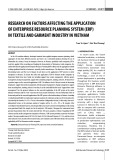

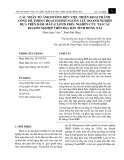
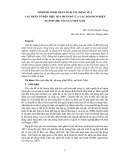
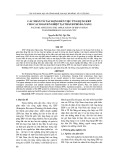
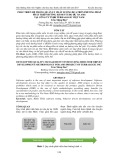
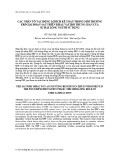
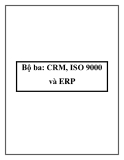




![Tối ưu hóa hiệu suất hệ thống: Bài thuyết trình [Chuẩn nhất]](https://cdn.tailieu.vn/images/document/thumbnail/2025/20251107/hiepdz2703@gmail.com/135x160/35941762488193.jpg)




![Bài giảng Quản trị chất lượng trong công nghiệp thực phẩm [chuẩn nhất]](https://cdn.tailieu.vn/images/document/thumbnail/2025/20250805/vijiraiya/135x160/637_bai-giang-quan-tri-chat-luong-trong-cong-nghiep-thuc-pham.jpg)
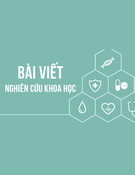
![Đề cương bài giảng Kỹ năng hoạt động công nghiệp [mới nhất]](https://cdn.tailieu.vn/images/document/thumbnail/2025/20250715/kimphuong1001/135x160/76971752564028.jpg)


![Bài giảng Kỹ thuật điều độ trong sản xuất và dịch vụ [mới nhất]](https://cdn.tailieu.vn/images/document/thumbnail/2025/20250630/dcbaor/135x160/13121751251866.jpg)


